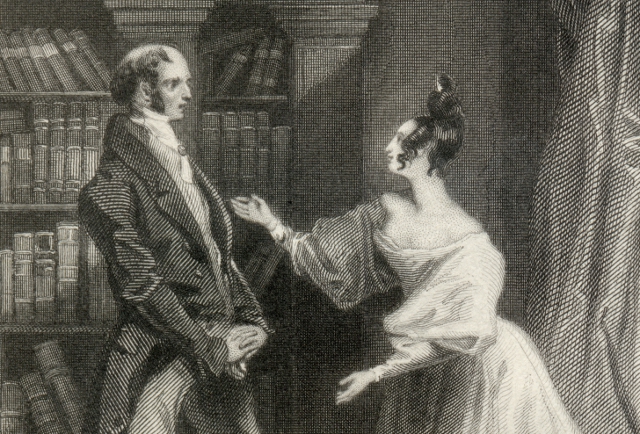(And Other Monetary Matters.)
Okay. I know this post is coming out of left field, but Netflix recently re-added Sense and Sensibility to the Watch Instantly library. Upon making this discovery I may – or may not – have squealed like a little girl and immediately turned it on. I love that movie.
But getting in an Austen mindset brought up one of the most irritating unanswered questions in fiction, and that is, “how much money are we talking about, here?” Money comes up a LOT in Jane Austen’s novels, and money (or the lack of it) is crucial to the plot of several of them. As far as I’m concerned, though, when the characters start talking about how many pounds so-and-so gets a year they might as well be talking about pounds of rocks for all that it helps me. In fact, pounds of rock would actually be more helpful, since I can imagine how much that actually is. Mr. Darcy gets 10,000 pounds of rock a year, you say? Why yes, that is a lot. I can see why the girls are impressed.
Not knowing is irritating, especially since it seems clear that Jane used specific amounts to give us information about her characters. Information that we aren’t getting! After a bit of searching I found a well-researched article from the Jane Austen Society of North America that translated the money in the books into 1988 US Dollars. Close! A lot of inflation has occurred since 1988, so I used an inflation calculator to translate those numbers into 2010 dollars (the most current measure available). I’ve looked at the numbers, and WOW, it really helps you to read the situation in a completely different way.
One more piece of information that will help give context to the numbers: although the dollar amounts have been adjusted for inflation, the economy in nineteenth century England was – at least for the average person – not heavily cash-based. The per capita income of the time was only about $1800. That’s 2010 dollars. (For comparison, the current per capita income of the USA is just under $40,000. That means that someone making (adjusted) $40,000 a year was making more than twenty times as much as the per capita…so even though the dollar amounts may not look like much it represents a great deal more wealth.
Without further ado; here’s the breakdown.
PRIDE AND PREJUDICE
Mr. Darcy: £10,000 a year = over $600,000 a year. Comparing the per capita amounts, that would be like having nearly $12 million a year. That’s how much more money he has than everyone else. That’s why everyone was talking about him. Also, I guess that explains how he lived in a place like this:

Mr. Bingley: Inherited £100,000 ($6 million) from his father. His yearly income was only half Mr. Darcy’s – £5,000 ($300,000) a year. His sisters had a fortune of £20,000 ($1.2 million) and thought very highly of themselves because of it.
Mr. Bennet had a yearly income of £2,000 or $120,000, and on that amount had to support himself, his wife, and 5 daughters.
When Lydia marries Mr. Wickham, Mr. Bennet is required to ‘settle’ £100 ($6,000) every year on her as part of the arrangements. He considered himself lucky and said that it would hardly cost him £10 ($600) more than he was paying for food, clothing, allowance, and money that Lydia wheedled out of her mother. Taking necessary clothing and food out of the equation, that still leaves at least $3,500 a year (about $300 a month) that Lydia spent on fun and frivolity. That’s two month’s pay for the average person that Lydia had to spend on her whims each month, something like $6,500 if we adjust by per capita amounts instead. It looks like the Bennets weren’t so poor after all, and it certainly shows better how spoiled and used to getting her way Lydia was. Mr. Bennet also mentioned that Wickham would have to be a fool to take Lydia for less than £10,000 ($600,000).
Mrs. Bennet inherited £4,000 ($132,500) and another £5,000 ($165,650) was settled on her at her marriage, to be divided between her and her children. If Mr. Bennet had died and none of her daughters had married, Mrs. Bennet and the girls would have from these two sources a yearly income of £450, or about $27,000. You can see why Mrs. Bennet was so anxious to have her daughters married, and FAST.
Mr. Wickham was left just over £1,000 ($60,000) by Mr. Darcy’s father, and when he gave up his claim to the Darcy parish he received another £3,000 ($180,000) from Darcy. It didn’t last, however, and Mr. Darcy paid another £1,000 ($60,000) of Wickham’s debts before he would agree to marry Lydia. It’s obvious, then, why he tried to elope with Georgianna Darcy with her £30,000 ($1.8 million) fortune. (Per capita comparison time again: that’s like $40 million.)
Fun fact! The chimney-piece at Rosings Park cost £800 ($48,000).
SENSE AND SENSIBILITY
Although his income is not specified in the book, it is estimated that John Dashwood had an annual income of £5,000-£6,000 ($300,000-$360,000).
When their father died, Elinor, Marianne, Margaret, and their mother were left with £10,000 ($600,000) to support the four of them. This gave them a combined income of £500 ($30,000) a year. Originally John intended to give each girl £1,000 ($60,000), but after discussing it with Fanny it dropped to £500 ($30,000) apiece, then to £100 ($6,000) a year total, then £50 ($3,000) a year total, then nothing… because he decided he couldn’t afford it.
Willoughby‘s estate Combe Magna was worth £600 ($36,000) a year but because of all his debt and the threat of disinheritance he chooses to marry Miss Grey, who has £50,000 ($3 million). Together, their assets would have given them an income of about £3,100 ($187,000) a year.
Edward Ferrars had an inheritance of £2,000 ($120,000) to call his own. If he had married Miss Morton – and her £30,000 ($1.8 million) – as his mother wished, he would have had £1,000 ($60,000) a year from his mother, £1,500 ($90,000) from his wife, and £100 ($6,000) from his inheritance for a total annual income of £2,600 (almost $157,000). When he refuses and is cut off, he has only his £100 ($6,000). Colonel Brandon offered him the Delaford living with £200 ($12,000) a year, and that plus the interest from Elinor’s £1,000 ($60,000) would give them £350 ($21,000) a year to live on. When Mrs. Ferrars gives Edward £10,000 ($600,000), however, their total yearly income increases to £850 ($51,000) which is enough to make them very comfortable.
In one scene Elinor and Marianne discuss the minimum amount of money necessary to live comfortably. Elinor says she would feel wealthy with £1,000 ($60,000) a year; Marianne says a family could not possibly be supported on less than £1,800-£2,000 ($108,000-$120,500) a year.
Colonel Brandon‘s income was about £2,000 ($120,500) a year, which is convenient because that’s exactly the amount Marianne said would make her happy.
If you have another Jane Austen price tag that’s been bothering you, just multiply it by 60 to get a rough estimate of the 2010 US Dollar amount that is equivalent. It really adds something extra to the stories!


Thank you for sharing your research on the income of Mr. Darcy etc. It really helps to understand all the fuss about how well “fixed” people are in Jane’s stories.
Great info. Who knew we were dealing with so much money. It makes me dislike Lydia all the more.